As the Copa America 2024 approaches, the Colombian National Team emerges as one of the tournament’s leading contenders.
They have now gone 20 games unbeaten and have a streak of true quality in their line-up.
However, with the competition set to take place in the United States from June to July, Colombia faces formidable challenges from football powerhouses like Brazil and Argentina.
Colombia have reached the Copa America final twice historically, finishing as runners-up in 1975 and capturing their first and only title in 2001.
Since that historic victory, they have been striving to reclaim the glory but have yet to add another Copa America trophy to their collection.
This year, the hopes and expectations surrounding the Colombian squad are higher than ever.
Boasting a roster filled with talent, including stars like Luis Díaz, James Rodríguez, and the promising young forward Jhon Durán, Colombia is well-equipped to make a deep run in the tournament.
In recent years, Colombia has demonstrated resilience and tactical flexibility, adapting their play style to counter various opponents.
Under the guidance of their astute coaching staff, the team has developed a blend of defensive solidity and attacking flair.
This tactical analysis will delve into the strategies, formations, and key players that could lead Colombia to triumph in this prestigious tournament.
As Colombia gears up for Copa America 2024, the entire nation eagerly watches, hoping to witness history being made once again.
Can this talented squad, with its blend of seasoned veterans and exciting new talents, navigate the challenges posed by South America’s elite and lift the Copa America trophy for the second time? This article aims to provide a comprehensive tactical analysis, shedding light on how Colombia can turn their potential into reality and achieve glory in the upcoming tournament.
Predicted Starting XI
Under the stewardship of Argentinian Head Coach Néstor Lorenzo, the Colombian national team has shown remarkable form in the lead-up to Copa America 2024, securing impressive victories over Romania and even Spain in recent friendly matches.
This success has highlighted the quality and cohesion of the squad, particularly in their favoured 4-2-3-1 formation.
This tactical setup has brought out the best in several key players, creating a balanced and formidable unit poised to challenge for the title.
We will take a closer look at these players later on in this article.
This predicted line-up showcases a blend of experience and youth, defensive solidity, and attacking flair.
However, the number 10 position remains a critical area of concern, especially with James Rodríguez’s recent injury issues.
Should he be unavailable, it will be imperative for Néstor Lorenzo to find an adequate replacement who can maintain the creative spark needed in that role.

Colombia’s 4-2-3-1 formation has proven effective in recent matches, and with their key players in form, they are well-positioned to make a strong impact at Copa America 2024.
The balance and quality throughout the squad offer hope for a deep run in the tournament as they aim to lift the Copa America trophy for the second time in their history.
In addition to the expected starting eleven, Colombia’s squad for Copa America 2024 features a talented and versatile group of players, each capable of making significant contributions.
This depth and flexibility provide Head Coach Néstor Lorenzo with numerous options and tactical variations to adapt to different opponents and match situations.
David Ospina, the 35-year-old veteran goalkeeper, brings a wealth of experience to the squad.
Known for his reflexes and leadership, Ospina remains a reliable backup option and a mentor for the younger goalkeepers.
Alongside him is Álvaro Montero, aged 29, whose physical presence and shot-stopping ability make him a solid choice in goal if needed.
Colombia boasts a mix of youth and experience in defence.
Yerson Mosquera, a promising 23-year-old centre-back, offers speed and strong tackling ability, making him a valuable asset in high-pressure situations.
Juan Cabal, also 23, adds depth and versatility to the defensive lineup.
Veteran Santiago Arias, 32, brings extensive international experience and can cover both full-back positions, providing defensive stability and leadership.
The midfield options are equally impressive.
Kevin Castaño, a dynamic 23-year-old midfielder, is known for his energy and ability to break up opposition plays.
Juan Portilla, aged 25, offers box-to-box capabilities, providing both defensive cover and offensive support.
Yáser Asprilla, at just 20 years old, is one of the exciting young talents, bringing creativity and flair to the midfield.
Jorge Carrascal, 25, adds another layer of creativity and can operate in multiple midfield roles, making him a versatile option for Lorenzo.
Colombia’s forward line is strengthened by the inclusion of several talented attackers.
Carlos Andrés Gómez, a 21-year-old forward, offers speed and a keen eye for goal, making him a valuable option off the bench.
Mateo Cassierra, 27, brings physicality and aerial prowess, providing a different attacking dimension.
Rafael Borré, 28, known for his work rate and clinical finishing, adds depth and experience to the forward line.
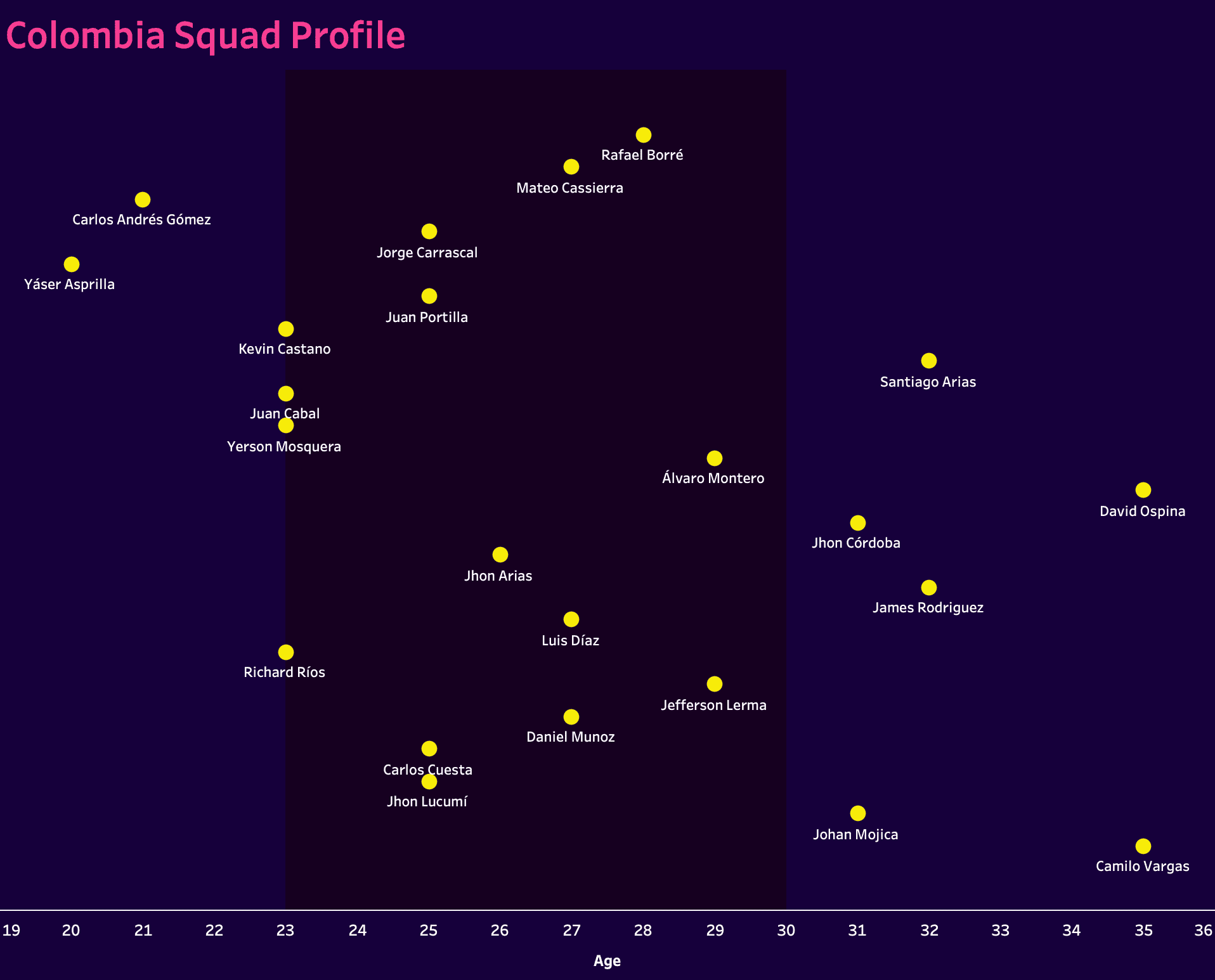
Each of these players has demonstrated their ability and potential in various competitions, ensuring that Colombia has a well-rounded and adaptable squad for Copa America 2024.
The combination of seasoned veterans and emerging talents creates a balanced team capable of competing at the highest level.
This depth will be crucial as Colombia navigates the challenges of the tournament, aiming to secure their second Copa America title.
Attacking Phase
In the attacking phase, Colombia’s approach is characterised by a mix of individual brilliance and collective effort, though it comes with both advantages and disadvantages.
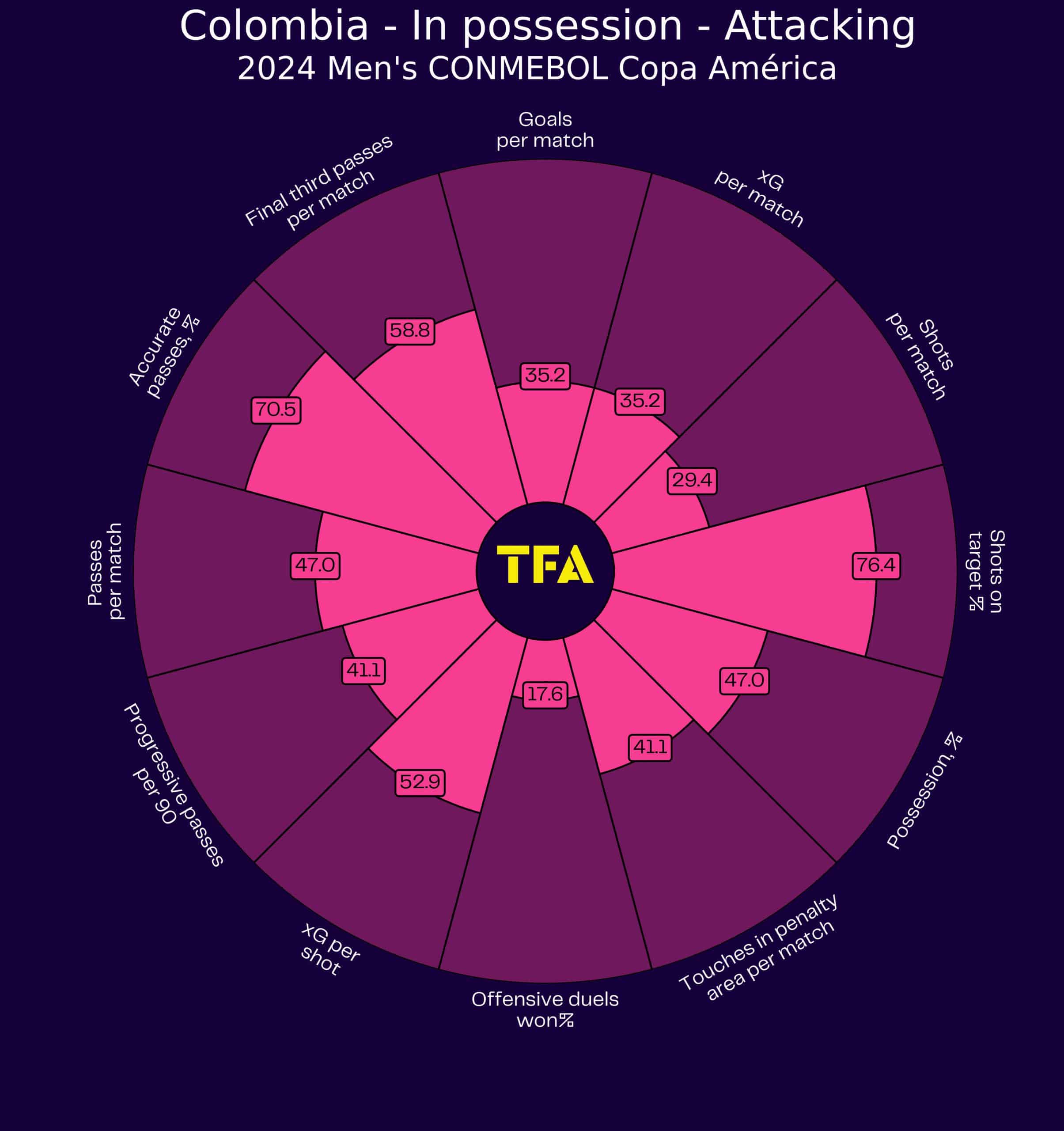
When James Rodríguez plays, Colombia’s attack benefits from his creativity and vision.
As a playmaker, Rodríguez has the ability to command the ball, stretch opponents, and create opportunities from almost any position on the field.
His passing range and ability to pick out runners make him a crucial asset in breaking down defences.
The team’s attacking effectiveness can be overly reliant on James Rodríguez.
When he plays, the team tends to look to him to orchestrate the attack, which can make their play predictable.
If Rodríguez is marked out of the game or has an off day, the whole attacking structure can falter.
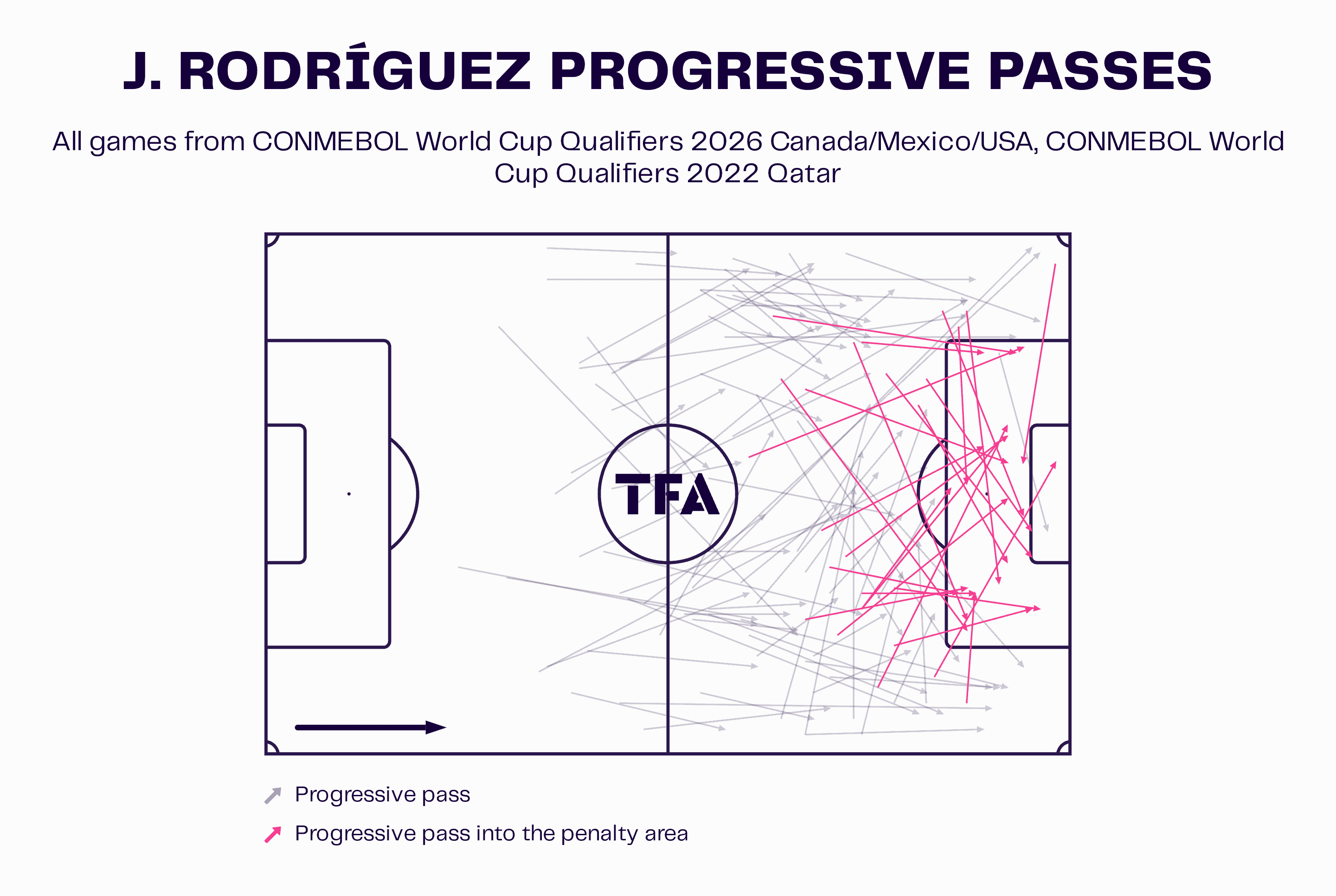
With players like Luis Díaz on the wings, Colombia possesses significant threat and dynamism.
Díaz’s pace and dribbling ability enable him to take on defenders, cut inside, and either shoot or deliver dangerous crosses into the box.
This wing play can unbalance defences and create spaces for other attackers to exploit.
While Colombia is capable of creating numerous chances, their finishing can be erratic.
For instance, against Spain, they controlled the game in the second half and created several opportunities but failed to convert enough of them to secure a more comfortable lead.
This inefficiency in front of goal can be costly, especially in tightly contested matches.
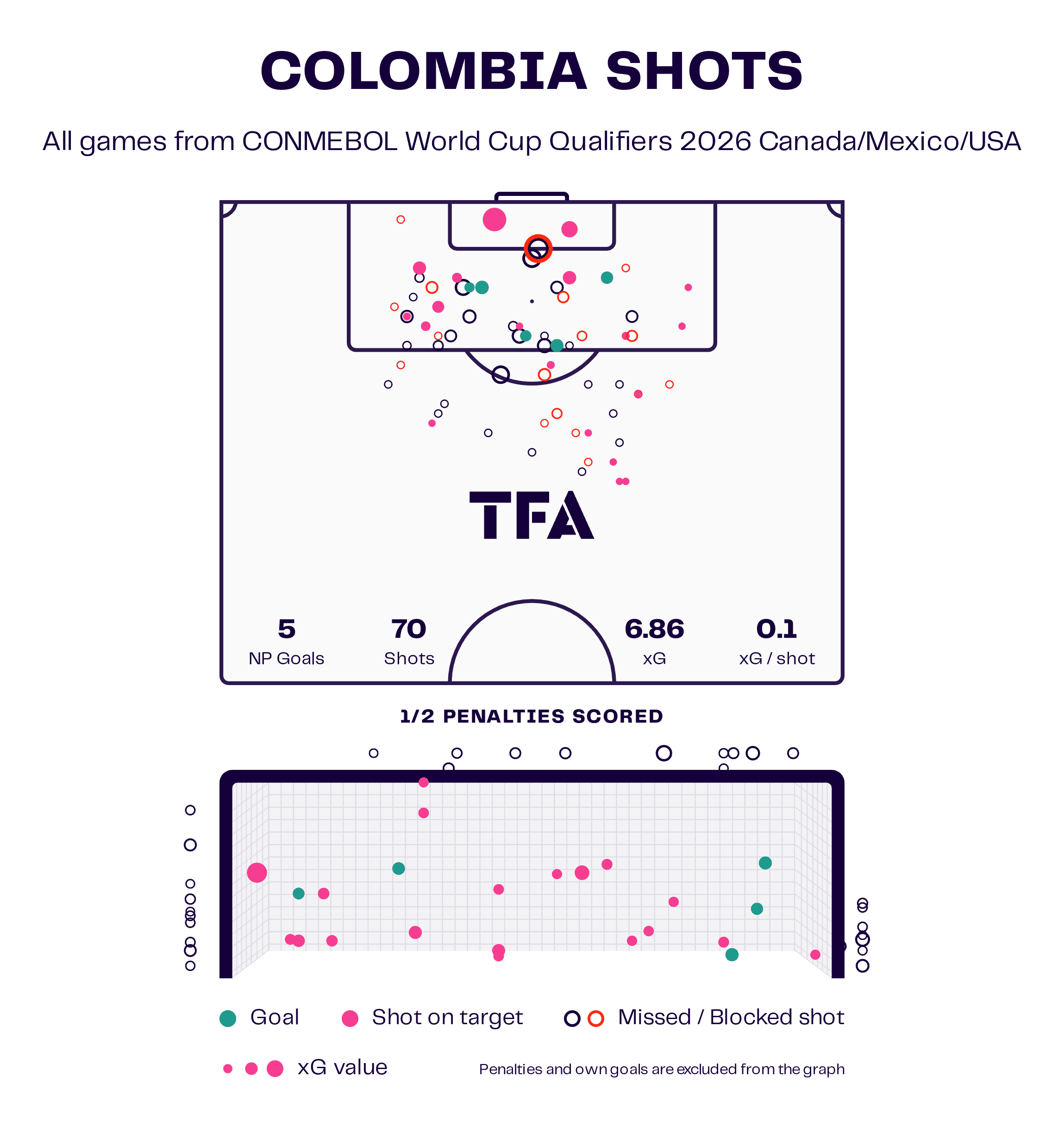
Despite the individual talents of their players, Colombia often struggles to maintain control of the game.
They sometimes lack the cohesion and composure in possession that is needed to dominate proceedings, which can lead to spells where they are chasing the ball rather than dictating play.
Colombia can look off the pace in possession, struggling to string together passes and maintain fluidity in their build-up play.
This inconsistency can result in turnovers and lost opportunities, putting unnecessary pressure on their defence.
Defensive Phase
A commitment to high-pressing and intense play in the defensive phase marks Colombia’s approach.
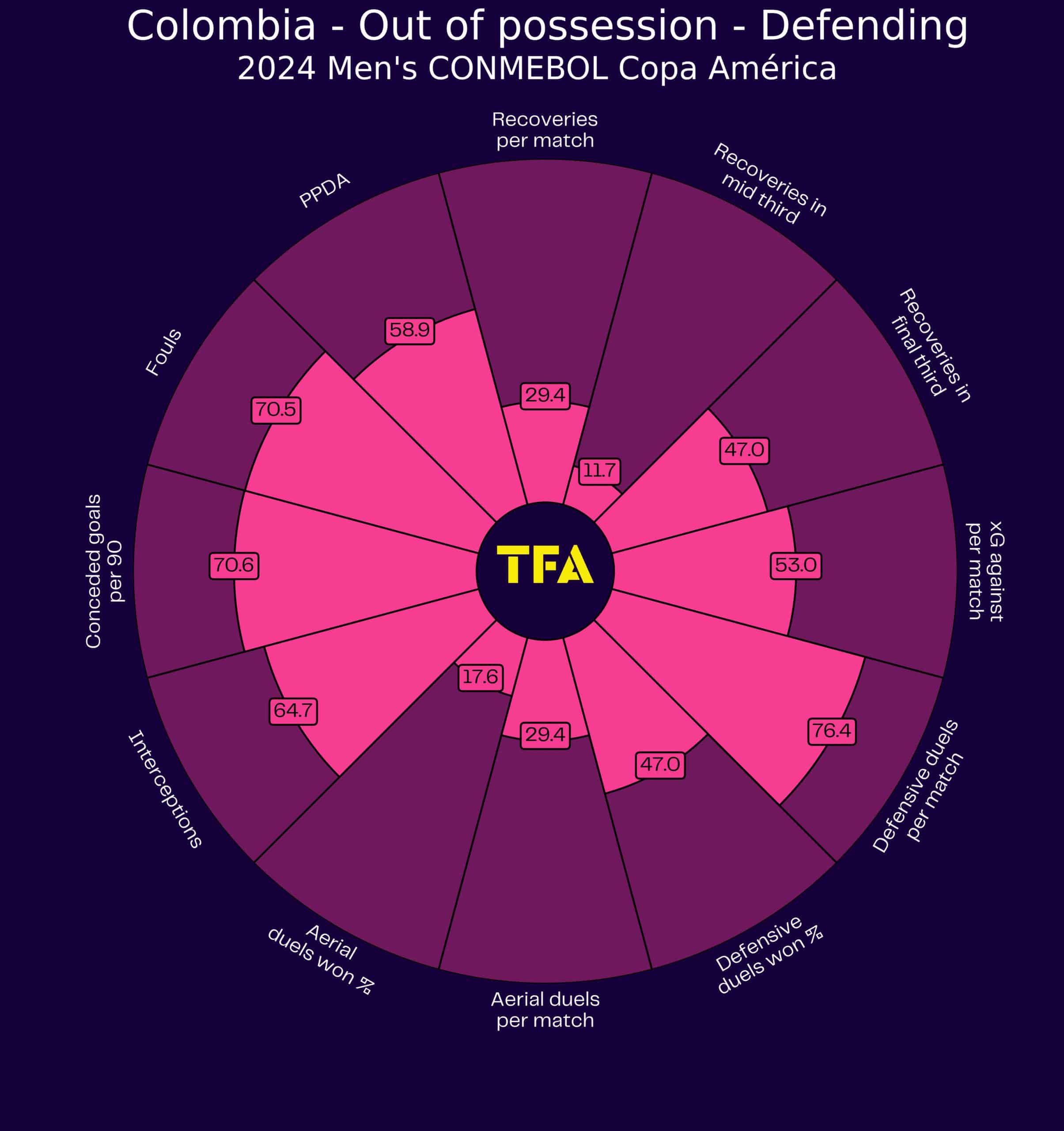
The team’s defensive play is characterised by its intensity and aggression.
Colombian players are known for their physicality and willingness to engage in duels, which can unsettle opponents and prevent them from finding a rhythm.
This relentless pressure can force mistakes and rushed decisions from the opposition.
The high-intensity approach demands a lot of energy from the players.
Maintaining such a level of intensity over the course of 90 minutes can be physically taxing, leading to fatigue and a potential drop in performance levels as the game progresses.
This can result in lapses in concentration and defensive errors.
Colombia often employs a high-pressing strategy, aiming to win the ball back as quickly as possible and disrupt the opponent’s build-up play.
This proactive approach can lead to turnovers in dangerous areas, providing immediate counterattack opportunities.
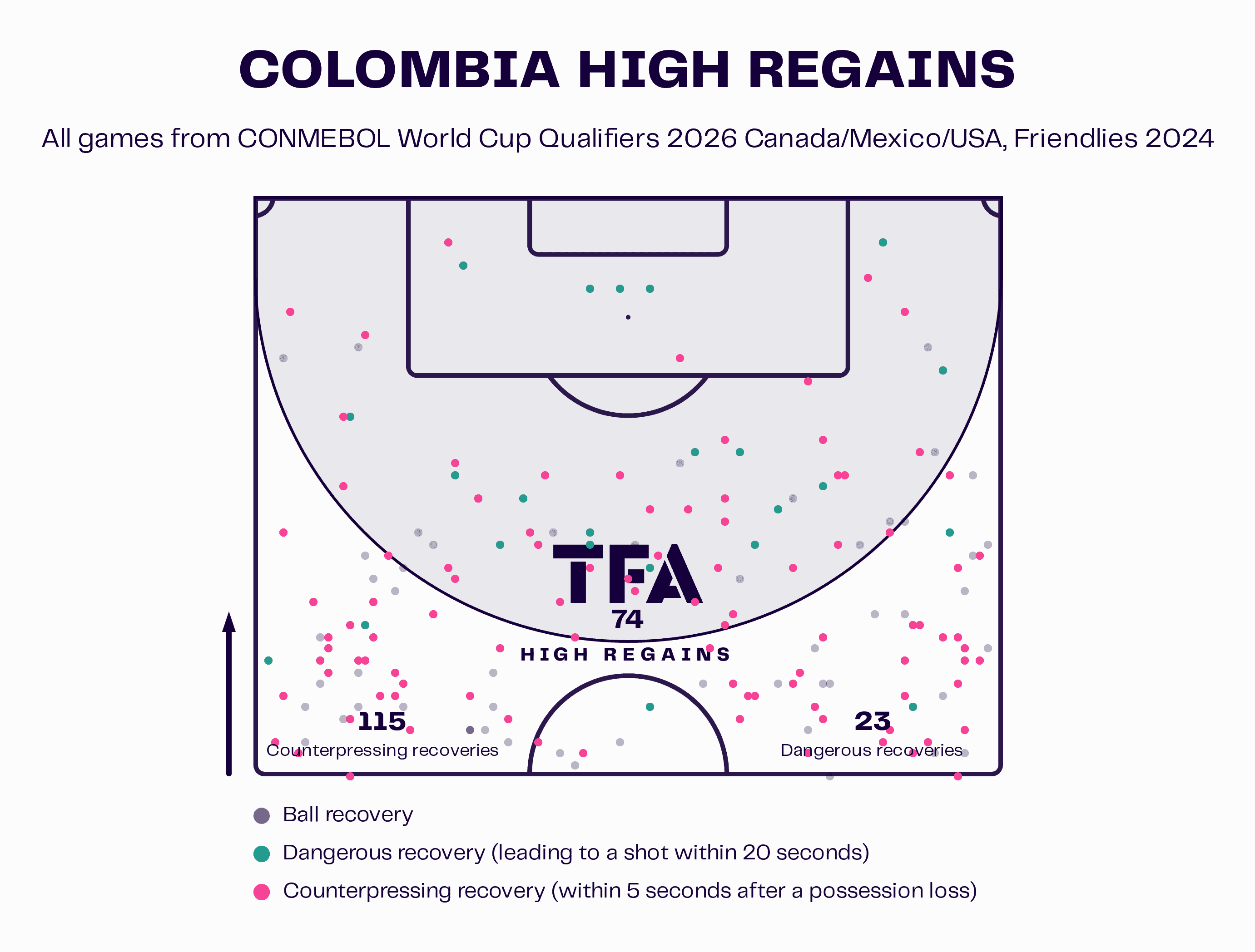
Despite their efforts to press high, Colombia is not always successful in maintaining this pressure throughout the game.
When the press is broken, it leaves significant gaps in their defence, exposing them to quick counterattacks.
This inconsistency can be exploited by technically adept teams who can bypass the press with quick, precise passing.
Opponents who are well-prepared can adjust their tactics to counter Colombia’s high press.
By playing out from the back with composure and stretching the play, teams can create opportunities to exploit the spaces left by the pressing players.
This tactical vulnerability can be a significant disadvantage against top-tier opponents.
However, when executing their high press effectively, Colombia can exhibit strong defensive cohesion.
The forwards and midfielders work in tandem to close down passing lanes and limit the space available to the opposition, making it difficult for them to progress the ball.
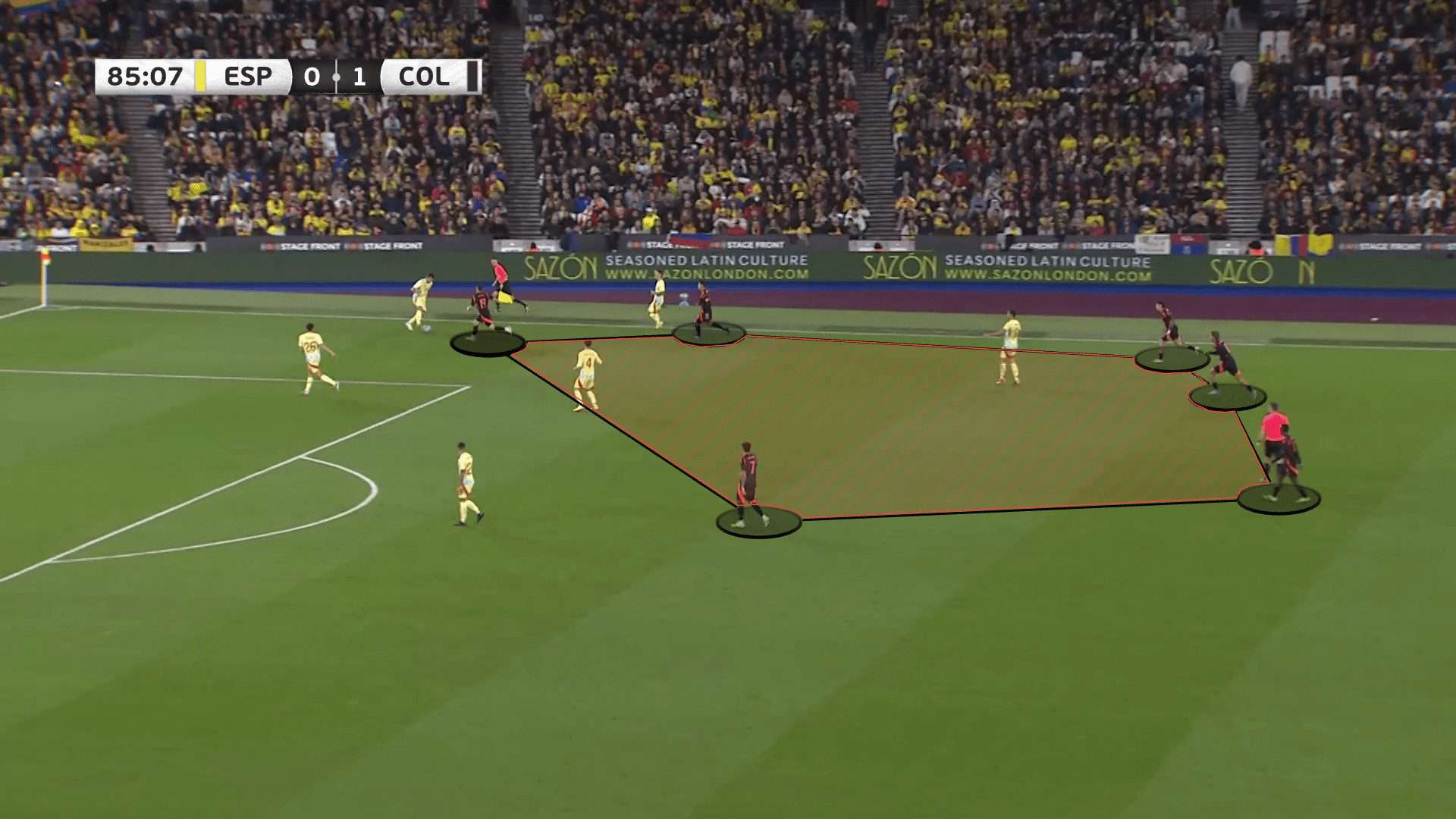
Transitions
Colombia’s approach in the attacking transition phase is heavily reliant on the individual qualities of their key players.
Colombia aims to play vertically as soon as they win the ball, seeking to catch the opposition off-guard.
This direct approach, often initiated by James Rodríguez’s long passes, is designed to bypass the midfield and create immediate goal-scoring opportunities.
It is an effective way to leverage the pace and positioning of players like Luis Díaz and Jhon Durán.
While effective, playing vertically as soon as possible can also be risky.
If the passes are intercepted, it can lead to turnovers, leaving the team vulnerable to counterattacks.
This approach requires precise execution, and any mistakes can quickly turn the transition in favour of the opposition.
James Rodríguez plays a crucial role in Colombia’s transitional play.
His exceptional vision and passing ability enable him to deliver precise long passes to the wingers, facilitating quick vertical play.
Rodríguez’s overview of the game allows him to pick out the right passes, often turning defence into attack in an instant.
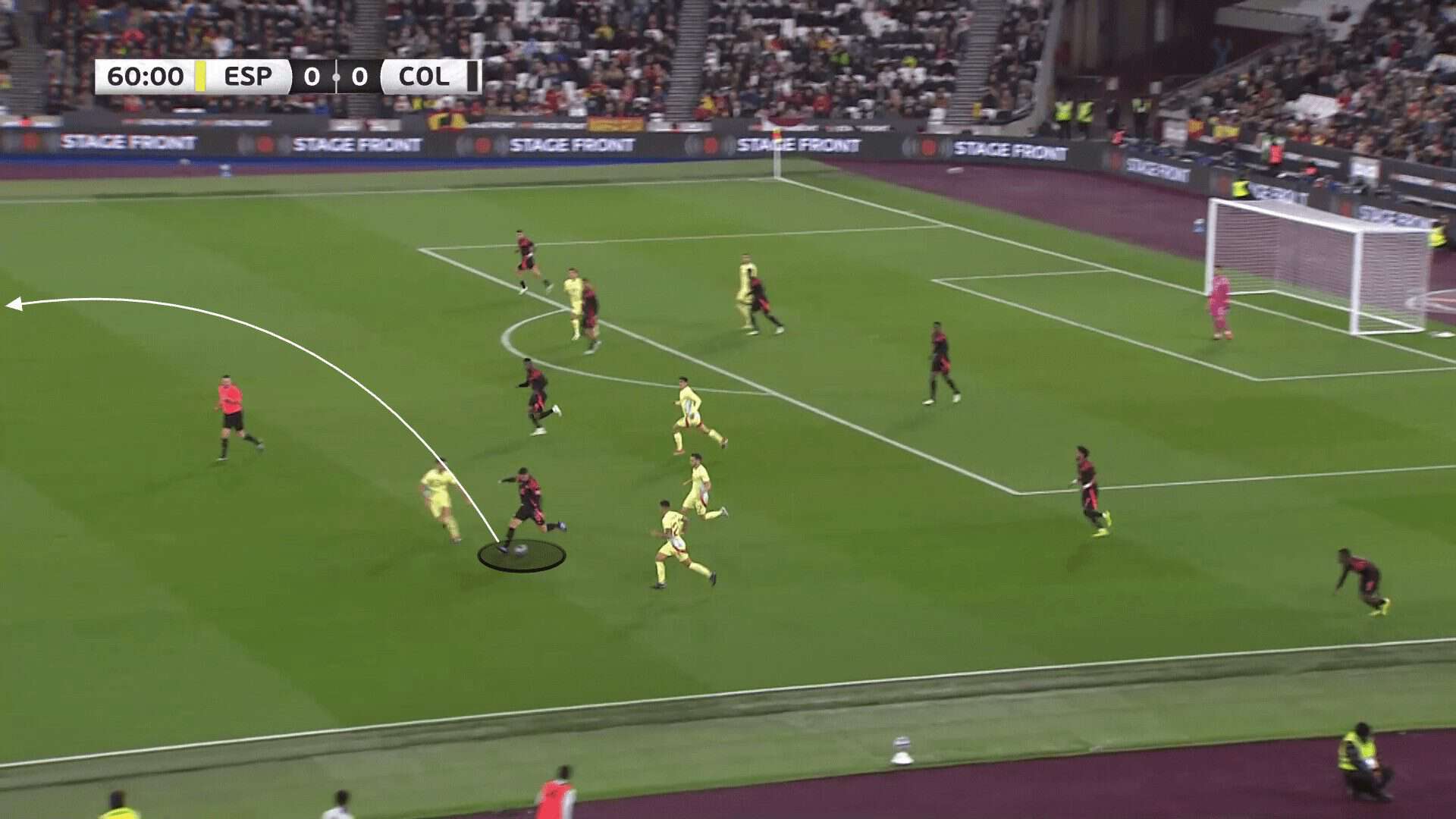
Luis Díaz’s exceptional pace and dribbling ability make him a potent threat on the counterattack.
His speed allows him to exploit spaces behind the opposition’s defence quickly.
By relying on the creativity and flair of their key players, Colombia’s transitions can be highly unpredictable and difficult for opponents to defend against.
The combination of Díaz’s speed and Rodríguez’s passing can create a variety of attacking scenarios, making Colombia a dynamic threat during transitions.
While individual brilliance can turn games, overreliance on solo efforts can sometimes lead to a lack of cohesion.
If players do not effectively combine their efforts, the team may struggle to execute coordinated transitional plays.
This can result in isolated attacks that are easier for opponents to defend against.
Forward
Leading the line is Jhon Córdoba, a powerful and experienced centre-forward.
Córdoba’s physicality and ability to hold up the ball allow Colombia to transition quickly from defence to attack.
His finishing ability and movement off the ball make him a constant goal threat, essential for capitalising on the chances created by the midfield and wingers.
Midfielders
The midfield double pivot consists of Jefferson Lerma and Richard Ríos.
At 29, Lerma brings a wealth of experience and a physical presence, capable of breaking up opposition plays and providing cover for the defence.
Ríos, the younger of the two at 23, complements Lerma with his energy, ball distribution skills, and ability to drive forward, creating a dynamic midfield duo.
On the wings, the attacking prowess of Luis Díaz and Jhon Arias is undeniable.
Díaz, playing on the left, is known for his explosive pace and ability to take on defenders, making him a constant threat in the attacking third.
On the right, Arias offers creativity and technical skill, capable of cutting inside or delivering precise crosses into the box.
These wide players are essential in stretching opposition defences and creating space for their teammates.
The number 10 role, a critical position in this formation, is filled by the talismanic James Rodríguez.
Despite missing some matches recently due to injury, Rodríguez’s vision, passing ability, and knack for scoring crucial goals make him indispensable when fit.
His presence adds a layer of creativity and unpredictability to Colombia’s attack, linking the midfield and the forward line seamlessly.
Defenders
In goal, Camilo Vargas, the experienced 35-year-old shot-stopper, has been a reliable presence.
His leadership and command of the penalty area provide a solid foundation for the team.
The backline features Johan Mojica at left-back, whose overlapping runs and defensive tenacity have been crucial.
In the centre of defence, the partnership of Jhon Lucumí and Carlos Cuesta combines youth and agility with strong defensive instincts.
Daniel Munoz, playing at right back, completes the defence with his ability to contribute both offensively and defensively.
Key Player
Luis Díaz from Liverpool FC is not only the captain but also undoubtedly the key player in Colombia’s squad for Copa America 2024.
His importance extends beyond just his technical skills.
Díaz’s role is crucial for several reasons from a tactical and analytical perspective.
From an analytical standpoint, Díaz’s statistics underline his importance.
His goal contributions, chances created, and successful dribbles per match highlight his impact in the attacking third.
His ability to consistently deliver in crucial moments and his influence on the game’s tempo make him a player that opponents must continuously monitor, thereby altering their defensive strategies and opening up opportunities for Colombia.
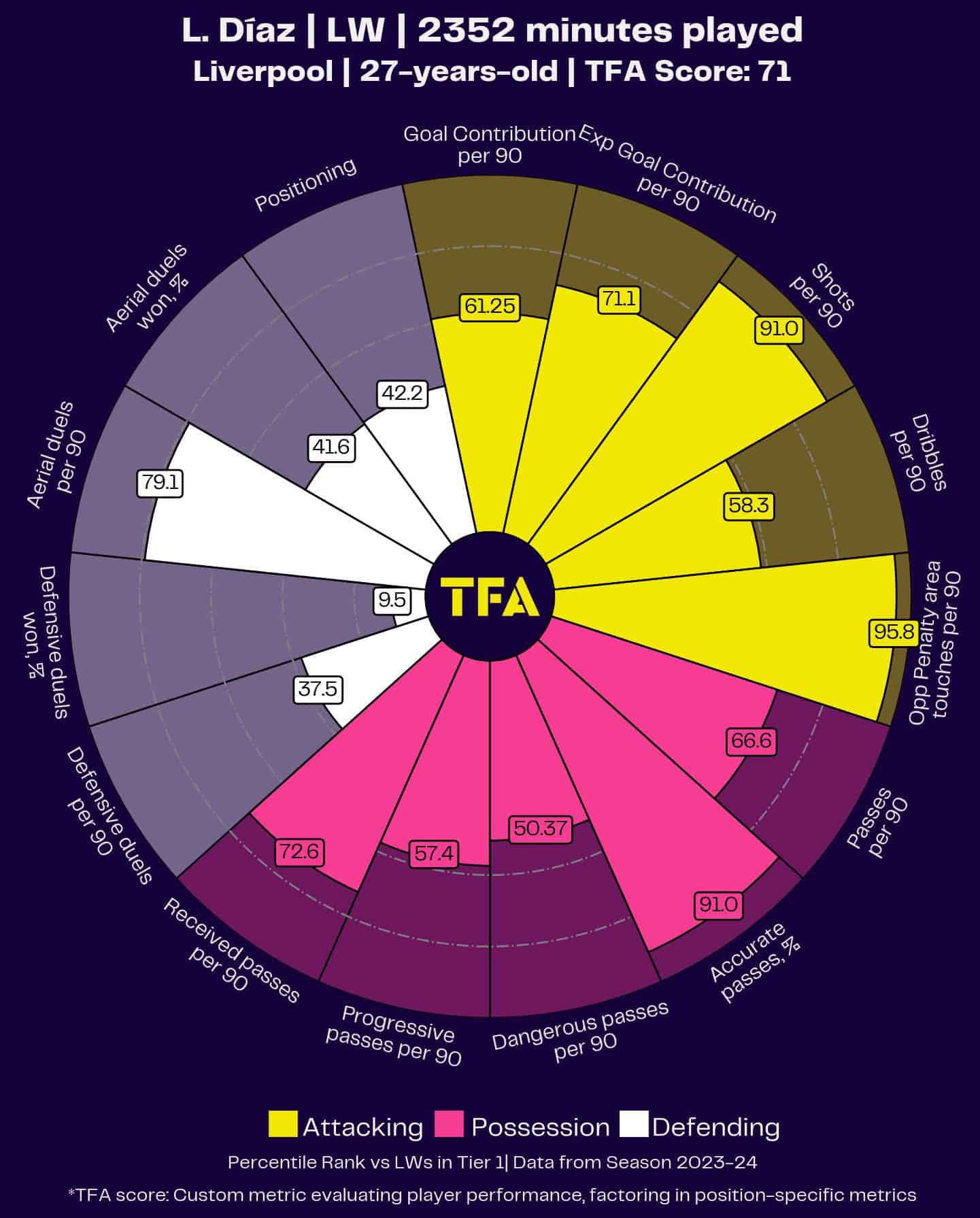
Díaz is a versatile attacker capable of playing on either wing or even as a forward, but his primary position on the left wing allows him to exploit his pace and dribbling skills.
His ability to cut inside from the left and shoot with his right foot or provide dangerous crosses makes him a dual threat, complicating opponents’ defensive plans.
Díaz’s exceptional dribbling and quick acceleration make him particularly effective at breaking through tight defensive lines.
In games where Colombia might face teams employing a low block, Díaz’s ability to take on defenders one-on-one and create scoring opportunities is invaluable.
His presence forces defenders to stay alert and often requires double-teaming, which can create space for his teammates.
One of Díaz’s standout attributes is his effectiveness on the counterattack.
His speed and direct approach make him a constant threat during transitional play.
When Colombia regains possession, Díaz can quickly turn defence into attack, stretching the field and exploiting spaces left by opposing teams.
His ability to carry the ball over long distances at pace is a significant asset in breaking down organised defences.
While Díaz is known for his offensive contributions, his defensive work rate is equally important.
He is diligent in tracking back and helping his full-back, ensuring that Colombia maintains a solid defensive structure.
This work ethic provides defensive stability and allows Colombia to press high up the pitch, with Díaz often leading the press to regain possession quickly.
Another tactical advantage is Díaz’s ability to combine with midfielders and forwards.
His chemistry with players like James Rodríguez and Jhon Córdoba allows for fluid attacking movements.
Díaz’s intelligent positioning and quick decision-making enable him to create and exploit spaces, facilitating effective link-up play that can dismantle defensive setups.
Díaz’s experience at Liverpool, competing in the Premier League and Champions League, has honed his skills and mental toughness.
He brings this high-level experience to the national team, providing leadership on and off the pitch.
His winning mentality and ability to perform under pressure are crucial for Colombia’s ambitions in the tournament.
Tournament Prediction
Colombia is expected to perform strongly in the group stage, benefiting from the blend of experience and youthful energy within their squad.
With players like Luis Díaz and James Rodríguez, they have the ability to dominate matches and secure crucial points.
Colombia is likely to finish at the top or at least second (behind Brazil) in their group, ensuring a smooth passage to the knockout stages.
Assuming Colombia advances from the group stage, the quarter-finals will present a stiffer challenge.
Potential matchups against teams like Uruguay or host USA could test their resilience.
Colombia’s ability to press high and transition quickly will be crucial here.
If their key players are in form, and the team executes their tactical plans effectively, they should be able to overcome their opponents and reach the semi-finals.
In the semi-finals, Colombia might face heavyweight Brazil again.
This will be a true test of their mettle.
The pace of Luis Díaz and the playmaking skills of James Rodríguez will be pivotal.
However, Colombia’s chances will depend heavily on their defensive solidity and ability to handle high-pressure situations.
While it will be a tough contest, Colombia has the potential to pull off an upset, especially if their star players perform at their peak.
If Colombia reaches the final, it would be a significant achievement and a testament to their growth as a team.
The final could hinge on small margins, individual brilliance, and tactical decisions.
While it would be a challenging match, Colombia’s blend of experience, youth, and tactical acumen gives them a realistic shot at lifting the Copa America trophy.

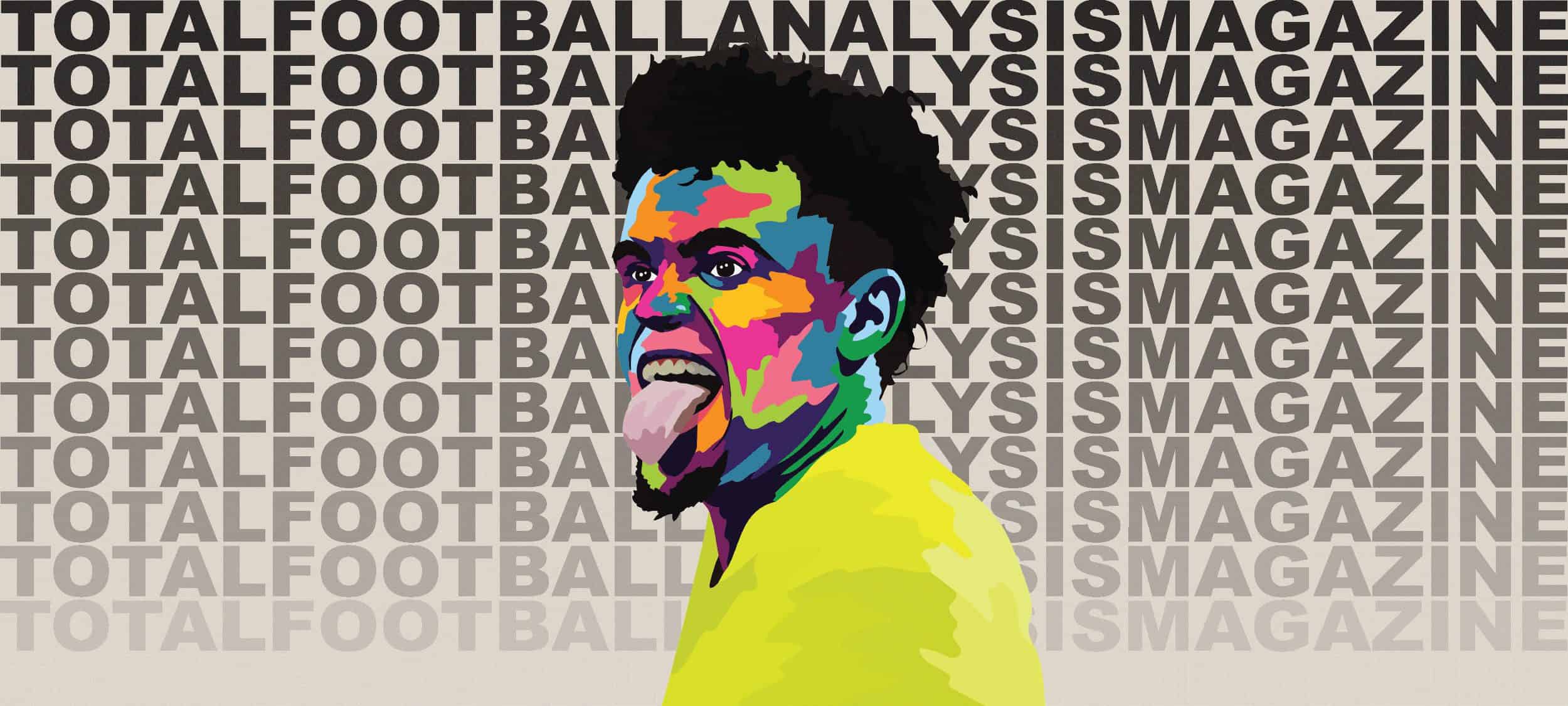



Comments